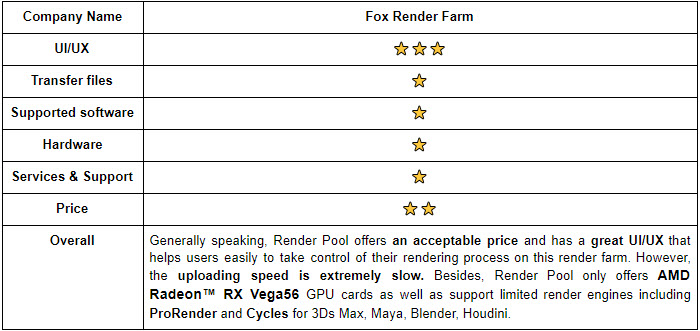Rate and Review Render Pool – Radarrender
Render Pool is a GPU based cloud rendering service provider based on SaaS (Software-as-a-Service) model and that uses multiple GPUs packed into each server on their network to achieve fast rendering speeds. Whether you work with VFX, CGI, 3D modeling, VR, or motion graphics, Render Pool will save you time and reduce your burden of hardware requirements. As a result, you can focus on new ideas, projects and enhancing the quality of your creativity. Today, let’s dig deep on what is offered to customers, and is it worth using cloud rendering service on Render Pool?

| Company Name | Render Pool |
| Website | https://renderpool.net/ |
| Country | Japan |
| Type of render farm | GPU |
| Free Trial | N/A |
First and foremost, the UI/UX is quite clear. They bring a simple dashboard including File Manager, Renders Manager, Payments, and Account Manager. In File Manager, you can easily click to Browse File to upload your project from your local computer to the Render Pool system, as well as control the Original Files that were uploaded and Rendered Files after rendering. In Renders Manager divides it into 5 parts including Create Queue where you set up everything before starting render, Running, Failed, Cancel, or Sucess to take control of the rendering process.
Uploading files is one of the severe issues needs to improve. We tested to render a single Blender file to the Render Pool system that is only 163MB. It took 2 minutes 10 seconds to upload this file, at an average of 1,25MB/s which is extremely slow. If you upload a larger project size, it can take you 30 minutes or hours to do it. In addition to the low uploading speed, the maximum upload file size to the Render Pool storage is just 50GB. Your original data is stored for one month, and your rendered data is stored for two weeks. Moreover, there are only 3 file formats that you are able to upload including RPR, RPRS, and BLEND, meanwhile, the output formats are only between PNG or EXR.
When it comes to types of supported software, Render Pool does not make us satisfied, it supports several 3D software packages by leveraging AMD graphics cards, AMD Radeon™ ProRender*, and Blender Cycles. AMD Radeon™ ProRender is a free rendering engine for visualization needs. Render farm offers support rendering ProRender engines with Maya, 3Ds Max, Blender, Unreal Engine, and Houdini. As ProRender is still new and unfamiliar with the design community, hence, there are a few software versions supported. In detail, Render Pool is able to support ProRender Maya 2017 and higher, ProRender Blender 2.79 and higher, ProRender 3Ds Max 2017 – 2019, ProRender Houdini 18.0 & 18.5, ProRender Unreal Engine 4.24. Other popular and widely used render engines such as Redshift, Octane, Vray, Arnold are not supported on workload. There is no doubt that the majority of designers and artists have been using the aforementioned render engines in terms of multi-GPU based rendering, at 95%. However, it does not give the rendering solutions for this giant piece of cake, their orientation focuses on exclusively ProRender render engines.
Hardware is one of the key factors that have a great impact on the rendering speed. Regarding Render Pool, because they support ProRender only which was developed by AMD, as a result, the GPU type that it provides is from AMD. To illustrate, Render Pool is dedicated to providing AMD Radeon™ RX Vega56. However, the performance of Radeon™ RX Vega56 is not impressive and outstanding when compared to the RTX graphics card developed by Nvidia. We can make a simple comparison between Radeon™ RX Vega56 (only 8GB VRAM) and GTX 1080Ti (11GB VRAM, the outdated graphics cards that most render farms support). According to Techpowerup, the performance of GTX 1080Ti is approximately one and a half as high as that of Radeon™ RX Vega56. More powerful GPUs such as RTX 2080Ti, RTX 3080 or RTX 3090 now supported by iRender Farm comprehensively defeat Radeon™ RX Vega56. Looking at the bright side, you are able to use many Radeon™ RX Vega56 cards to speed up your rendering time, the number of graphics cards can be up to hundreds.
Next, we would like to talk about it farm Pricing. Render Pool’s services can be used from the exceptional price of¢3.0/GPU/minute with ProRender Base Renderer. On the other hand, Basic Blender Cycles rendering starts from¢6/GPU/min. For instance, we tested a Blender file that consists of 200 frames. On our local computer, the spec is GTX 1060, it took us 2 hours to render all 200 frames. It cost 5.2$ for the Standard package, 10.4$ for and 15.61$ for the Rush package and it took a couple of minutes to receive the result. It can be said that Render Pool offers an acceptable and affordable price to customers.
However, customer service is a serious drawback of Render Pool. We have never met this situation before. For other render farms, they have quick support via email, 24/7 support via live chat, Skype, or WhatsApp. In contrast, I could not contact Render Pool. Without live chat, Render Pool also does not place their email address on their website. The only way we could communicate with them for help is by writing a message via the contact page.

Render Pool made us frustrated because it always shows “There was an error trying to send your message. Please try again”. We tried hundreds of times, but nothing happened. It’s the reason why we voted 1 star for Render Pool in terms of customer service.

WE RANK






